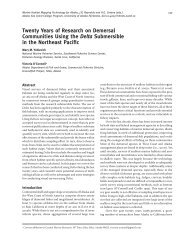724_Final Report.pdf - North Pacific Research Board
724_Final Report.pdf - North Pacific Research Board
724_Final Report.pdf - North Pacific Research Board
You also want an ePaper? Increase the reach of your titles
YUMPU automatically turns print PDFs into web optimized ePapers that Google loves.
Calibration coefficients (CCs) and FA subset selection<br />
The CC values estimated from the eiders after sixty-nine days on the same diet (Day 0) ranged from 0.03<br />
for 22:2d7,13 and 22:2d7,15 to 4.26 for 21:5n-3 (Fig. 3). CC values of 1.0 indicate a 1:1 ratio of FA<br />
deposition from diet (Fig. 3). CCs were higher in eiders than in common murre chicks Uria aalge for<br />
16:1n-9, iso17:0, 18:1n-11, 18:1n-9, 21:5n-3, and 24:1n-9 (Fig. 3).<br />
The performance of FA subsets in the QFASA model was dependent on eider species and diet<br />
(Table 2). Of the 25 other FA subsets modified from the published Dietary and Extended Dietary FA<br />
subsets, test 18 (Reduced A) and test 21 (Reduced B) FA subset had the lowest total SSE across all diets<br />
and were determined to be the best FA subsets for modeling diets for spectacled and Steller’s eiders,<br />
respectively (Table 2). The Dietary and Extended Dietary FA subsets from Iverson et al. (2004) were also<br />
used in the simulations and modeling for comparison.<br />
QFASA model<br />
The five specified pseudo diets were well estimated using QFASA simulations (Table 1). The Reduced<br />
A, B, Dietary, and Extended Dietary FA subsets produced similar results, however the Extended Dietary<br />
subset estimated proportions of individual species within each diet generally closer to the true values<br />
(Table 1). Furthermore, the prey-on-prey simulations showed that the diet items in the captive eider diet<br />
database were correctly identified as themselves 93% - 100% out of 1000 simulations (Fig. 4). Mussels<br />
had the lowest identification rate with the widest distribution, while clams and Mazuri had the highest<br />
identification rate (Fig. 4). Thus, although mussels were misclassified as other diet items (< 7% as clam,<br />
krill and Mazuri), in general the diet items in this study were reliably distinguished from one another.<br />
We used the Reduced A, B, Dietary and Extended Dietary FA subsets in the model along with<br />
species-specific CCs calculated for spectacled and Steller’s eiders. For comparison, we also modeled<br />
eider diets using the Extended Dietary subset and the common murre chick CCs from Iverson et al.<br />
18



